

Adolescent sugar-sweetened beverage intake is associated with parent intake, not knowledge of health risks November 2018 external icon.Daily adolescent sugar-sweetened beverage intake is associated with selected adolescent, not parent, attitudes about limiting sugary drink and junk food intake January 2020 external icon.Dietary and physical activity behaviors among high school students – Youth Risk Behavior Survey, United States, 2019 August 2020.CDC Podcast: Sugary Drinks Curb the Colas.Rethink Your Drink: Options for reducing the number of calories you drink.

CDC TYPE 2 DIABETES INFOGRAPHIC HOW TO
A Data User’s Guide to the BRFSS Sugar-Sweetened Beverage Questions: How to Analyze Consumption of Sugar-Sweetened Beverages pdf icon.Additionally, adolescents who frequently drink SSBs also have more screen time, including more time with televisions, cell phones, computers, and video games. SSB consumption is associated with less healthy behaviors.Īdults and adolescents who smoke, don’t get enough sleep, don’t exercise much, eat fast food often, and who do not eat fruit regularly are more likely to be frequent consumers of SSBs.


Sugar-sweetened beverages are any liquids that are sweetened with various forms of added sugars like brown sugar, corn sweetener, corn syrup, dextrose, fructose, glucose, high-fructose corn syrup, honey, lactose, malt syrup, maltose, molasses, raw sugar, and sucrose.1-4 Limiting sugary drink intake can help individuals maintain a healthy weight and have healthy dietary patterns. Frequently drinking sugar-sweetened beverages is associated with weight gain, obesity, type 2 diabetes, heart disease, kidney diseases, non-alcoholic liver disease, tooth decay and cavities, and gout, a type of arthritis. Sugar-sweetened beverages (SSBs) or sugary drinks are leading sources of added sugars in the American diet.


 0 kommentar(er)
0 kommentar(er)
